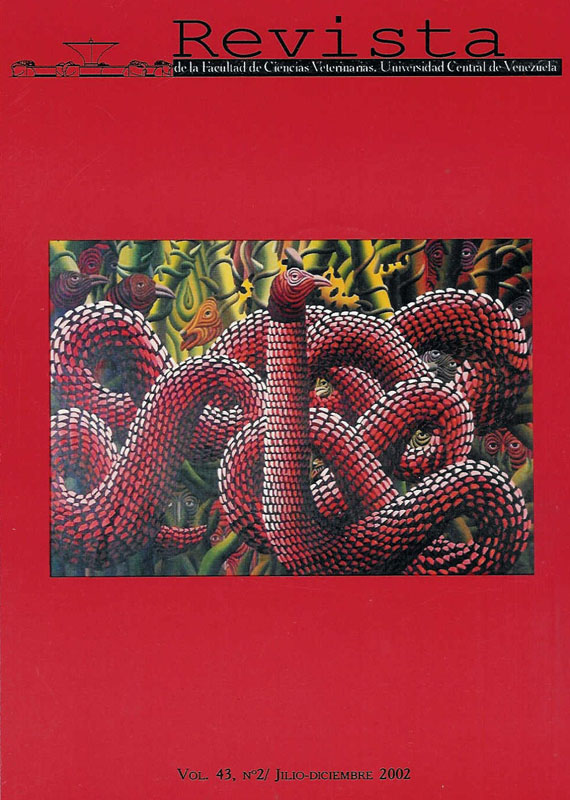RELACIÓN ENTRE CARACTERÍSTICAS BIOMÉTRICAS Y PESO CORPORAL EN CORDEROS WEST AFRICAN
Contenido principal del artículo
Resumen
Con el objeto de estudiar la relación entre el peso corporal (PC) y algunas características biométricas en corderos West African en crecimiento, para predecir el PC sin necesidad de balanza, se realizó un ensayo utilizando 47 corderos desde el nacimiento hasta los 90 días de edad. Para tal fin se efectuaron quincenalmente las siguientes mediciones: PC, perímetro torácico (PT) detrás de la espalda (escápula), profundidad torácica (PR) tomando la distancia entre la línea dorsal y la esternal, inmediatamente posterior a la espalda, alzada (AL) midiendo la distancia entre la base de la pezuña y la cruz, longitud desde la base de la cabeza (L1) (articulación occipito-atlantal) hasta la base de la cola (primera vértebra coccígea; y la longitud desde la articulación del encuentro (L2) (escápulohumeral) hasta la punta de nalga (articulación coxo-femoral). Los datos fueron analizados para determinar la correlación simple de Pearson entre el PC y PT, PR, AL, L1 y L2, y por el método de los cuadrados mínimos para determinar ecuaciones de regresión lineal simple, múltiple, stepwise y cuadrática para predecir PC usando PT, PR, AL, L1 y L2. Los estimados para las correlaciones fueron 0,96; 0,95; 0,86; 0,93 y 0,91, respectivamente (p<0.01). Se pudo concluir que el mejor estimador para determinar el peso fue el PT, a través de una regresión lineal simple: PC= -16,66 +0,548 PT, ya que la precisión con que determina la ecuación es alta (r2 =0.93). La regresión cuadrática mejora el estimador (r2 =0.96), pero no se justifica utilizarla para predecir el peso ya que la diferencia con la regresión lineal simple fue de 1.7% y se hace más compleja la ecuación desde el punto de vista práctico.
Relationship between Biometric Traits and Body Weight in West African Lambs
Abstract
In order to study the relationship between body weight (BW) and some biometric traits in West African lambs, to predict BW without a scale, an experiment using 47 animals, from birth to 90 daysold was carried out. The following measurements were taken once every 15 days: BW, thoracic perimeter (TP) girthing the animal behind the back, thoracic depth (TD) taking the distance between the spine and the esternal line, behind the back of the animal, wither height (WH) taking the distance between the base of the hoof and the wither, length from the occipito-atlas joint to the first coccygeal vertebrae (L1) and the scapulahumeral joint to the coxo-femoral joint (L2). Data were analyzed to estimate Pearson simple correlation between BW and TP, TD, WH, L1 and L2, and by least square method to fit different types of regression: linear, multiple, stepwise and quadratic to predict BW from TP, TD, WH, L1 and L2. The resulting estimates of correlation were 0.96; 0.95; 0.86; 0.93 and 0.91, respectively (p<0.01). It could be concluded that the best estimator to predict weight is the simple lineal regression on TP using the equation: BW = -16.66 +0.548 TP since the precision with which it determines the equation is high (r2 =0.93). The quadratic regression improved the estimation (r2 =0.96) but its use is not justified because the difference with the simple lineal regression was only 1.7% and is more complex the equation for the practice.
Relationship between Biometric Traits and Body Weight in West African Lambs
Abstract
In order to study the relationship between body weight (BW) and some biometric traits in West African lambs, to predict BW without a scale, an experiment using 47 animals, from birth to 90 daysold was carried out. The following measurements were taken once every 15 days: BW, thoracic perimeter (TP) girthing the animal behind the back, thoracic depth (TD) taking the distance between the spine and the esternal line, behind the back of the animal, wither height (WH) taking the distance between the base of the hoof and the wither, length from the occipito-atlas joint to the first coccygeal vertebrae (L1) and the scapulahumeral joint to the coxo-femoral joint (L2). Data were analyzed to estimate Pearson simple correlation between BW and TP, TD, WH, L1 and L2, and by least square method to fit different types of regression: linear, multiple, stepwise and quadratic to predict BW from TP, TD, WH, L1 and L2. The resulting estimates of correlation were 0.96; 0.95; 0.86; 0.93 and 0.91, respectively (p<0.01). It could be concluded that the best estimator to predict weight is the simple lineal regression on TP using the equation: BW = -16.66 +0.548 TP since the precision with which it determines the equation is high (r2 =0.93). The quadratic regression improved the estimation (r2 =0.96) but its use is not justified because the difference with the simple lineal regression was only 1.7% and is more complex the equation for the practice.
Descargas
Detalles del artículo
Número
Sección
Artículos de Investigación

